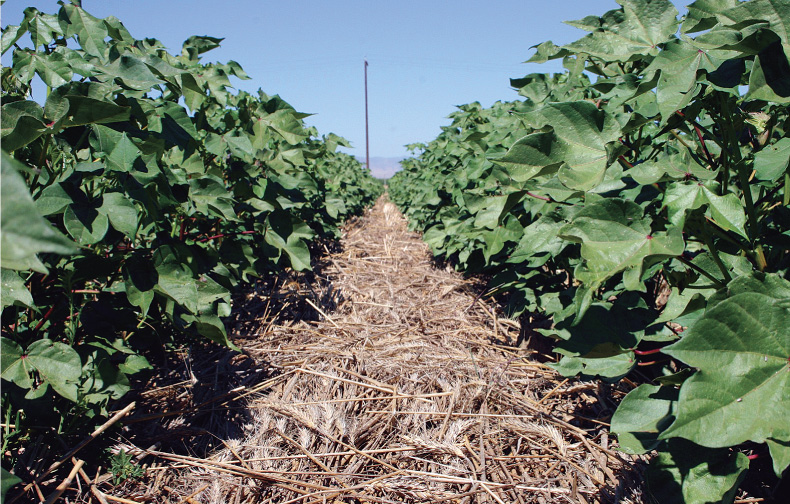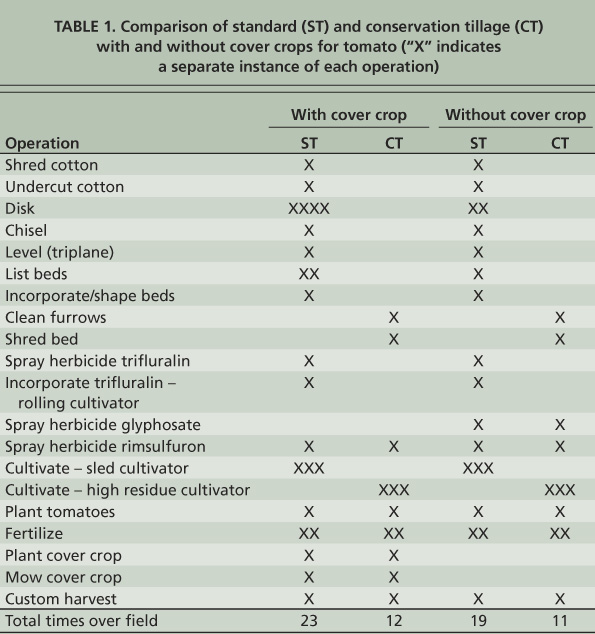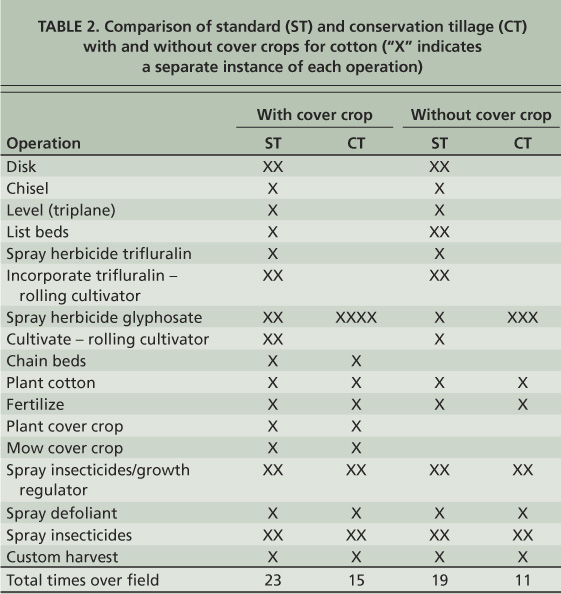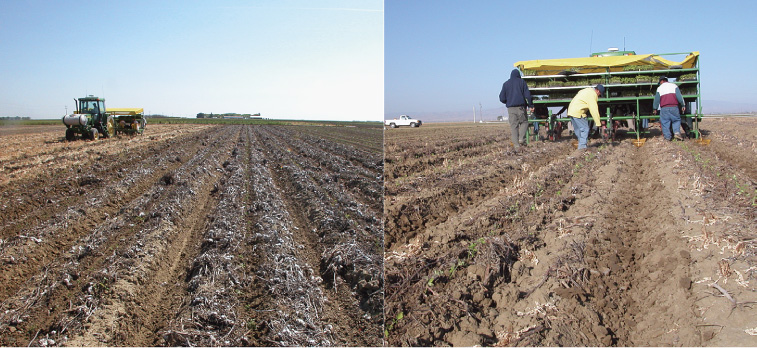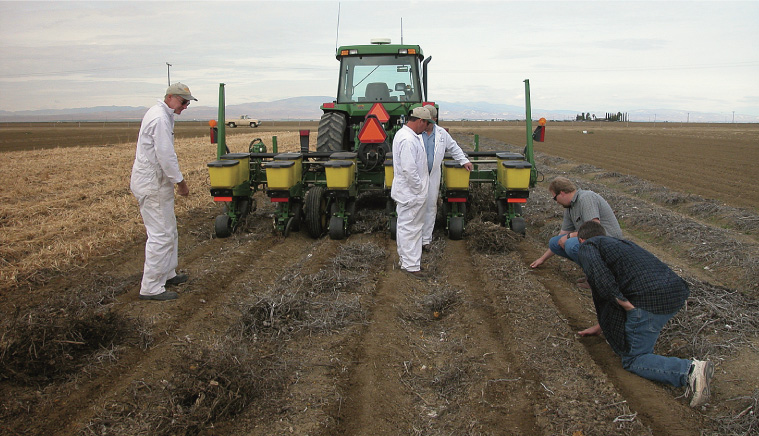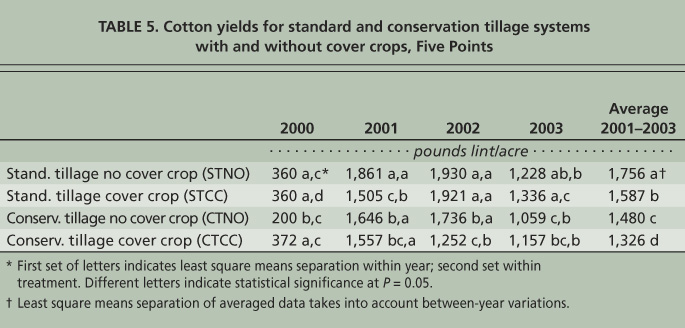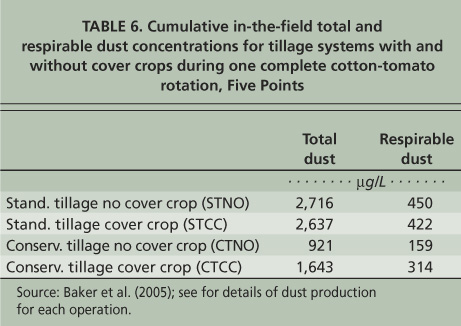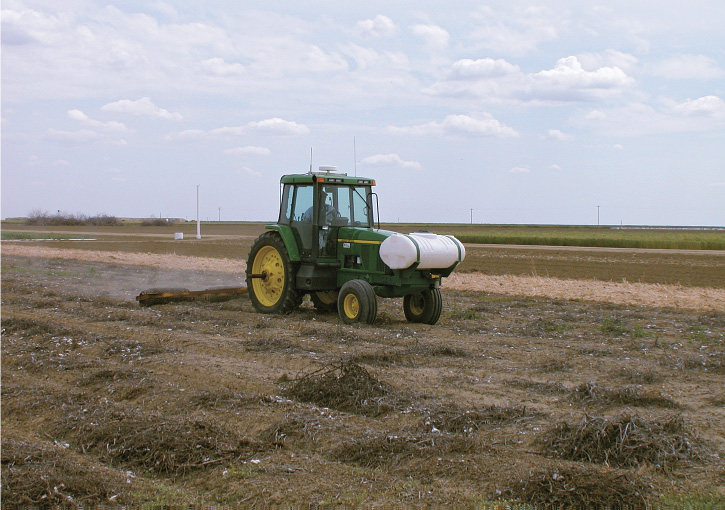All Issues
Transition to conservation tillage evaluated in San Joaquin Valley cotton and tomato rotations
Publication Information
California Agriculture 62(2):74-79. https://doi.org/10.3733/ca.v062n02p74
Published April 01, 2008
PDF | Citation | Permissions
Abstract
We compared standard tillage (ST) and conservation tillage (CT) for tomato and cotton production systems, with winter cover crops (CC) and without (NO), in Five Points, Calif., from 1999 to 2003. Conservation tillage reduced tractor trips across the field by 50% for tomatoes and 40% for cotton compared to standard tillage. When averaged over the 2001 to 2003 period (when the conservation tillage systems were established), tomato yields in CTNO were 6 to 8 tons per acre higher than the other treatments. In cotton, the STNO cotton yields during this period were the highest of all treatments and were 276 pounds per acre higher than the CTNO system. In-field dust concentrations were also significantly reduced by conservation tillage. Our results suggest that conservation tillage may be a viable alternative for managing tomato and cotton crops in the San Joaquin Valley, but that fine-tuning of the systems is needed.
Full text
IN the San Joaquin Valley, cotton and tomato production systems rely on considerable intercrop tillage to prepare the soil for seeding. Tillage clears the soil surface of residues, permits greater soil warming in the spring and clean harvest conditions in the fall, and provides weed control. In cotton, tillage facilitates pink bollworm (Pectinophora gossypiella) pest control following harvest by mixing cotton residues with the soil. Many tillage practices, however, can be a significant production cost, a cause of soil organic matter losses and a source of particulate matter emissions.
Conservation tillage allows growers to reduce the number of times that tractors are run through their fields, for savings in time, energy and labor. The authors studied how the practice, with and without cover crops, affects yields, dust production and other factors in a cotton-tomato rotation. Above, cotton grown in a cover crop.
On average, 9 to 11 separate tillage-related operations, each involving heavy equipment, are conducted during the fall through spring to prepare the soil for summer cropping in most current San Joaquin Valley cotton and tomato production fields. Deep tillage often is used in these systems to alleviate compaction that results from frequent tillage passes and harvest operations. These operations account for up to 20% of production costs (Carter 1996), and require high energy and increased subsequent effort to prepare seed beds.
The adoption of conservation tillage (CT), or reduced tillage practices, may be a viable means for improving field-crop production systems if their profitability and capacity to conserve natural resources can be demonstrated. In their many and varied forms, conservation tillage systems aim at reducing primary, intercrop tillage operations such as plowing, disking, ripping and mulching. As a result of these deliberate reductions in tillage, surface residues may accumulate and must be managed, and new techniques for crop establishment must be developed. Despite the potential attractiveness and utility of reduced-tillage production alternatives, conservation tillage adoption rates in agronomic row crops are very low in California, less than 2% (CTIC 2004).
Reasons for California's low adoption rate include a lack of locally available conservation tillage equipment, inexperience with conservation tillage techniques, the predominance of surface, or gravity, irrigation systems and the fact that the tillage-intensive systems used in the San Joaquin Valley for several decades are generally quite productive (Mitchell et al. 2007).
Key
STNO standard tillage without cover crop
STCC standard tillage with cover crop
CTNO conservation tillage without cover crop
CTCC conservation tillage with cover crop
CT field comparison
In fall 1999, we established a field comparison of conservation and standard tillage in cotton and tomato rotations, with and without winter cover crops, at the University of California West Side Research and Extension Center in Five Points, Calif. The objectives of the study were to compare conservation tillage and conventional tillage practices in crop rotations common to the San Joaquin Valley in terms of productivity and profitability, key soil quality indicators (Veenstra et al. 2006) and the quantity of dust produced. We report here aspects of how the tillage systems performed during the first 4 years of the study.
Conventional intercrop tillage practices that knock down and establish new beds following harvest were used in the standard tillage (ST) systems (tables 1 and 2). The conservation tillage systems were managed from the general principal of trying to reduce primary, intercrop tillage to the greatest extent possible. Zone production practices that restrict tractor traffic to furrows were used in the conservation tillage systems, and planting beds were not moved or destroyed in these systems during the entire 4 years.
An 8-acre field in a map unit of Panoche clay loam (fine-loamy, mixed, superactive, thermic Typic Haplocambids) (Arroues 2006) was used for the study, and a uniform barley (Hordeum vulgare) crop was grown over the entire field before beginning the treatments. The field was divided into two halves with a processing tomato (Lycopersicon esculentum)/cotton (Gossypium hirsutum L.) rotation on one half and a cotton-tomato rotation on the other. Management treatments of standard tillage without cover crop (STNO), standard tillage with cover crop (STCC), conservation tillage without cover crop (CTNO) and conservation tillage with cover crop (CTCC) were replicated four times in a randomized complete block design on each half of the field. Treatment plots consisted of six beds, each measuring 30 feet by 270 feet. Six-bed buffer areas separated tillage treatments to enable the different tractor operations that were used in each system.
Cover crops.
A cover crop mix of Juan triticale (Triticosecale Wittm.), Merced ryegrain (Secale cereale L.) and common vetch (Vicia sativa) was planted at a rate of 100 pounds per acre (30% triticale, 30% ryegrain and 40% vetch by weight) in late October in the standard and conservation tillage plus cover crop plots, and irrigated once in 1999. In each of the subsequent years, no irrigation was applied to the cover crops, which were planted in advance of any early winter rains. The cover crops were chopped in mid-March of the following years using a Buffalo Rolling Stalk Chopper (Fleischer, Neb.). In the STCC system, the chopped cover crop was disked into the soil to a depth of about 8 inches, and 5-foot-wide beds were reformed prior to tomato transplanting. The chopped cover crop in the CTCC system was sprayed with a 2% solution of glyphosate and left on the surface as a mulch.
Tomato.
In the tomato-planted half of the field, plants of the variety ‘8892’ were transplanted in the center of beds at an in-row spacing of 12 inches during the first week of April in each year, using a modified three-row commercial transplanter fitted with a 20-inch coulter ahead of each transplanter shoe. Treatments received the same fertilizer applications, with dry fertilizer (11-52-0 NPK) applied preplant at 100 pounds per acre. Additional nitrogen (urea) was side-dress applied at 125 pounds nitrogen per acre in two lines about 7 inches from the transplants and about 6 inches deep, about 4 weeks after transplanting.
TABLE 1. Comparison of standard (ST) and conservation tillage (CT) with and without cover crops for tomato (“X” indicates a separate instance of each operation)
TABLE 2. Comparison of standard (ST) and conservation tillage (CT) with and without cover crops for cotton (“X” indicates a separate instance of each operation)
With conservation tillage, tractor trips were reduced about 50% for tomato and 40% for cotton at the Five Points study site. Above, processing tomatoes are transplanted into cotton and cover crop residues.
Cotton.
The RoundUp Ready (glyphosate-resistant) upland cotton (Gossypium hirsutum) variety ‘Riata’ was used each year in all cotton systems and was established using a John Deere (Moline, Ill.) 1730 No-till Planter. Cotton was planted in two lines on the same 5-foot “permanent” beds that were not broken down and reshaped following tomatoes, as is customarily done and as we did in our standard tillage plots, which were disked down and reworked into 30-inch beds for cotton. The preemergent herbicide trifluralin (Treflan) was applied and soil-incorporated twice as is the regional custom, to better mix the chemical with the soil. An application of 140 pounds of urea fertilizer per acre was made in each year in each system, using a fertilizer shank fitted with an 18-inch coulter to cut residues about 10 inches to the side of plants and about 6 inches deep.
Tractor use.
All tractor traffic was restricted to the furrows between planting beds in the conservation tillage systems; no tillage was done in the conservation tillage plots following tomatoes and preceding the next cotton crop, and only two tractor passes were conducted following cotton and preceding each subsequent tomato crop. These operations included shredding and uprooting the cotton stalks in order to comply with “plow down” regulations for pink boll-worm control in the region and a furrow sweep operation to clean out furrow bottoms to improve irrigation water movement down the furrows.
Yields.
Tomato yields were determined in each year using field weighing gondola trailers following the commercial machine harvest of each entire plot. Cotton lint yields were determined using whole-plot seed cotton weights multiplied by gin turnout percentages determined on samples sent through the UC Shafter Research and Education Center research gin.
Dust.
Total dust (TD) (< 100 μm [micrometers] aerodynamic diameter) and respirable dust (RD) (4 μm aerodynamic diameter) were collected on Teflon (PTFE) membrane filters suspended in the plume generated by field implements during each tillage operation in 2001 and 2002, in order to describe relative in-field dust production of each tillage system (Baker et al. 2005). The samplers were attached to each field implement about 15 inches above the ground surface, with the exception of the cotton harvester samples, which were placed at approximately 6 feet above the ground. The samplers were attached to battery-operated pumps operated at a flow rate of 2.2 liters per minute. Dust concentrations from each tillage or harvest operation were calculated from the mass of dust collected on preweighed filters, the pump air-flow rates and the duration of the operation. Cumulative dust concentrations for the four treatments were calculated by summing the mean values of all operations contributing to a particular treatment over a complete cotton-tomato rotation.
Data analysis.
The data were analyzed as an unbalanced mixed model using SAS statistical software (SAS Institute 2003). This model took into account variability associated with switching crops (such as tomato-cotton, cotton-tomato rotation) on experimental plots nested in blocks year after year. Treatments were not analyzed as a factorial combination of cover crop and tillage. Therefore, simple and main factorial effects are inferred in this paper.
In the 4-year study, researchers successfully established and harvested a cotton-tomato rotation using conservation tillage, with some equipment modifications. Above, a no-till cotton planter (into tomato residue) is evaluated and adjusted.
Trips across the field
During the 4 years of this study, the number of tractor trips across the field was reduced by about 50% for tomato (table 1) and 40% for cotton (table 2) in the conservation tillage systems relative to standard tillage. Differences in the tillage intensity between systems were due primarily to reductions in soil-disturbing operations commonly associated with postharvest land preparation, including disking, chiseling, leveling and relisting beds — operations that are typically performed in the fall.
TABLE 3. Cotton plant stand establishment for standard and conservation tillage systems with and without cover crops, Five Points
TABLE 4. Processing tomato yields for standard and conservation tillage systems with and without cover crops, Five Points
The operations listed in tables 1 and 2 represent average sequences for all years; slight differences occurred in certain years. For instance, we originally performed two operations following cotton harvest in the conservation tillage systems: a one-pass Shredder-Bedder (Interstate Mfg., Bakersfield, Calif.) to shred and undercut the cotton plant, and a furrow sweeping operation using a Buffalo 6000 High Residue Cultivator (Fleischer Mfg., Columbus, Neb.) modified and fitted with only furrow implements. In 2003, however, we fitted our no-till tomato transplanter with furrow “ridging wings,” and thereby cleared out residues from furrow bottoms at the time of transplanting.
The general conservation tillage approach pursued in this study was to more severely restrict tillage operations than is customarily done today. As a result, more residues accumulated on the soil surface, particularly in the CTCC systems, and this at least partly explains the lower numbers of cotton plants that were established in this system in each year relative to the STNO system (table 3).
In addition, we were initially concerned that residues would interfere with the action of the “over-the-top” tomato herbicide rimsulfuron (Shadeout), which can be sprayed after transplanting and sprinkled in to activate. By 2003, however, we used it in all systems with observed benefits. For conservation tillage cotton, we relied solely on one or two in-season applications of glyphosate; no cultivation was done in these systems. For tomatoes, we typically cultivated two to three times, but based on visual estimates of weed populations this did not achieve a comparable level of weed control in the conservation tillage systems as in the standard tillage systems in all years. This is one aspect of our conservation tillage approach that needs to be improved.
While the conservation tillage systems we employed in this study dramatically reduced overall tillage and soil disturbance relative to the standard tillage norms for the San Joaquin Valley, they by no means constitute what is customarily considered “no-till” production. In classic no-till, or “direct seeding” systems, crops are planted directly into residues and no additional soil disturbance is generally done prior to harvest. We employed an intermediate or incremental tillage reduction strategy in part to clear channels for the movement of irrigation water down furrows and in part to meet California Department of Food and Agriculture (CDFA) mandates for pink bollworm control in cotton. Current CDFA regulations require uprooting cotton roots postharvest and potentially some residue burial. Recent changes in the CDFA Pink Bollworm Management Program allow for reduced postharvest tillage in cotton fields with no pink bollworm findings, or in fields outside of a 9-square-mile radius from a pink bollworm trapping find. These changes should make it easier to adopt conservation tillage practices.
Crop performance
Tomato.
Tomato yields during the first 4 years of this study were generally similar in the conservation tillage and standard tillage systems, with some years showing significant differences (positive and negative) (table 4). Processing tomato yields in 2000 were slightly lower in each of the cover-cropped systems relative to both the standard and conservation tillage systems without cover crops. This may have been caused in part by slower early-season tomato growth that was observed in each of the cover-cropped systems. We speculate that this growth reduction resulted from nitrogen immobilization following cover crop termination each spring, and, in the case of the CTCC system, lower soil and near-surface air temperatures. Additional testing is now under way to evaluate each of these hypotheses.
Data from the 2001 tomato harvest indicates that yields in conservation tillage both with and without cover crops were similar to those in the standard tillage plots. In both 2002 and 2003, the highest-yielding system was conservation tillage without a cover crop, although yield was significantly higher than all other treatments only in 2002. Using a cover crop meant lower yields for the conservation tillage system in all years, although yield was not significantly lower in 2001 or 2003.
Interestingly, for the standard tillage system a cover crop increased yields in 2001 and again in 2003 compared to the STNO treatments. Using the averages for 2001 to 2003, the period during which the tillage systems had become “established” following the 1999–2000 set-up year, CTNO had significantly higher yields than the other treatments (table 4). This suggests a possible tillage-system-by-cover-crop interaction, where cover crops significantly lowered tomato yields in the conservation tillage system but not in the standard tillage system.
TABLE 5. Cotton yields for standard and conservation tillage systems with and without cover crops, Five Points
TABLE 6. Cumulative in-the-field total and respirable dust concentrations for tillage systems with and without cover crops during one complete cotton-tomato rotation, Five Points
Tomato fruit quality (% soluble solids and pH) data were not collected in every year of the study and did not indicate consistent system or treatment trends when determinations were made, presumably because similar irrigation water volumes were applied to all systems. Though we did not consistently monitor weed populations during this study, we did generally observe more weeds with cover cropping, and particularly in the furrows, for both tomato and cotton. There is a need to improve weed management in these systems, particularly late in the season.
Cotton.
Cotton yields (table 5) were low in all systems in 2000 due to a devastating infestation of mites that persisted all season, exacerbated by likely pesticide resistance problems that developed with repeated miticide applications. In 2001 and 2002, STNO yields were significantly higher than in both conservation tillage systems. The STCC system was comparable to the CTNO system in 2001, but higher in 2002 and 2003. When the period 2001 through 2003 is averaged, the STNO system yielded 276 pounds more cotton lint than the CTNO system (table 5). While plant populations in these systems were similar, lower yields in the CTNO system may have resulted from reduced early-season crop vigor and a greater incidence of plant “skips” (areas within the row greater than 3 feet in length where no plants emerged) in this system. In addition, the lower yields may have been due to larger plants with more bolls in the first position (located closest to the main stem on a fruiting branch), which are typically correlated with greater yields in the STNO system.
Unlike tomatoes, there seemed to be no tillage-system-by-cover-crop interactions in cotton. The systems without cover crops consistently had higher yields than those with cover crops. Reduced yields in the conservation tillage systems, and the STCC system in 2001, may in part be related to difficulties we experienced establishing the crops in these systems, which resulted in lower average plant populations (table 3) and reduced early-season crop vigor. A combination of factors may be involved, however, as prior UC studies of cotton yield responses to plant population would not predict yield reductions at populations shown in table 3 (Kerby et al. 1996). Further work to refine and improve our planting, establishment, weed and nutrient management of cotton in these systems is under way.
Dust production
In-the-field dust concentrations, both total and respirable, measured on tillage and harvest implements were significantly reduced in the conservation tillage treatments compared to standard tillage for the 2001 to 2002 period of measurements (table 6). Gravimetric analysis showed that dust concentrations for CTNO were about one third of their STNO counterparts for both cumulative total and respirable dust measured throughout the 2-year rotation, primarily due to fewer in-field operations and to the elimination of the dustiest operations that cause significant soil disturbance. For example, both standard tillage systems utilize disking and power incorporation during land preparation, and these two operations are the dustiest of all operations (average of 60 to 65 micrograms per liter [μg/L] TD for each disking and 105 to 164 μg/L TD for power incorporation) (Baker et al. 2005). The elimination of cotton cultivation, the dustiest in-season operation in the standard tillage systems (average of 51 μg/L TD per cultivation) (Baker et al. 2005), also contributed significantly to overall dust reduction in the conservation tillage systems. Planting and harvesting operations, which cause little soil disturbance, produced similar amounts of dust in all treatments.
The total and respirable dust production for STNO and STCC were comparable, even though STCC entailed more field operations. The CTCC system produced about twice as much total and respirable dust as CTNO due to an increased number of field operations to manage the cover crop and an increased organic fraction in the dust (Baker et al. 2005). We did not measure PM10 and PM2.5 (particulate matter with aerodynamic diameters of 10 and 2.5 μm, respectively) at locations downwind from our field sites, so the effects of the conservation tillage systems on ambient air quality in relation to U.S. Environmental Protection Agency standards are not completely clear. However, our data does allow comparisons of the relative dustiness of the production systems. It is reasonable to assume that reduced dust measured at the implement level would translate to reduced ambient dust if conservation tillage practices were adopted widely. At this point, it remains unclear whether the reduced dust in conservation tillage treatments is due solely to a reduction in the number of field operations, or if it is also related to changes in soil properties such as aggregation and soil organic matter content.
Transitioning to CT
Our results indicate short-term outcomes and issues associated with a conversion to conservation tillage production in an irrigated region such as California's Central Valley. These preliminary results suggest that establishing and harvesting processing tomatoes and cotton with conservation tillage is possible given some equipment modification. In tomato, yields were maintained or even slightly improved with conservation tillage compared with standard tillage practices.
The negative impacts of conservation tillage systems on cotton yields were more problematic during the course of this study. A number of possible constraints to the adoption of these high-residue production systems were observed during this “transition” period and these require further investigation. First, the continued, long-term accumulation of large quantities of crop residues on the soil surface may eventually present problems in terms of planting, cultivating and harvesting both tomatoes and cotton. Transplanting and cultivating tomatoes took more time in the CTCC plots relative to the standard till systems, in part due to the need to deal with residues.
Second, although we did not quantify the actual amount of residue picked up by harvesting equipment, it is possible that high surface-residue systems may result in greater “material other than tomatoes” being harvested, which would ultimately require increased cleaning efforts and perhaps expense at harvest.
Third, although “zone production” theory might suggest that soil compaction constraints may, to a large extent, be avoided by keeping tractor traffic away from “crop growth zones,” (Rechel et al. 1987), longer-term studies that investigate the implications of reduced till on compaction zones in a bed system are needed. An additional area of study worthy of evaluation is the determination of fertilizer application methods under conservation tillage. The adequacy of these approaches in meeting crop requirements will need to be determined for more soluble nutrients (such as nitrogen), as well as for less mobile or highly fixed nutrients (such as phosphorus and potassium).
Tomato yields were maintained or improved in the 4-year conservation tillage study, but cotton yields were more problematic. Above, tomato residues are ring-rolled prior to no-till cotton planting.
Finally, this transition-phase study has identified problems with cotton productivity and profitability in conservation tillage that will need to be addressed and improved. Achieving robust and vigorous cotton stands and developing reliable fertility and fertilizer application programs for conservation tillage are important areas that need further attention.
This study is the first of its kind in California to systematically compare tillage system alternatives through an agronomic field-crop rotation. The extent to which such alternatives are adopted in this region will ultimately depend on: yield impacts, true input costs, and how these affect profitability; equipment costs for alternative systems; decisions about weeding; the management of insect and disease pests over time; and possibly, whether processors and ultimately consumers find sufficient value in these types of production approaches to provide cost offsets to support their adoption.



